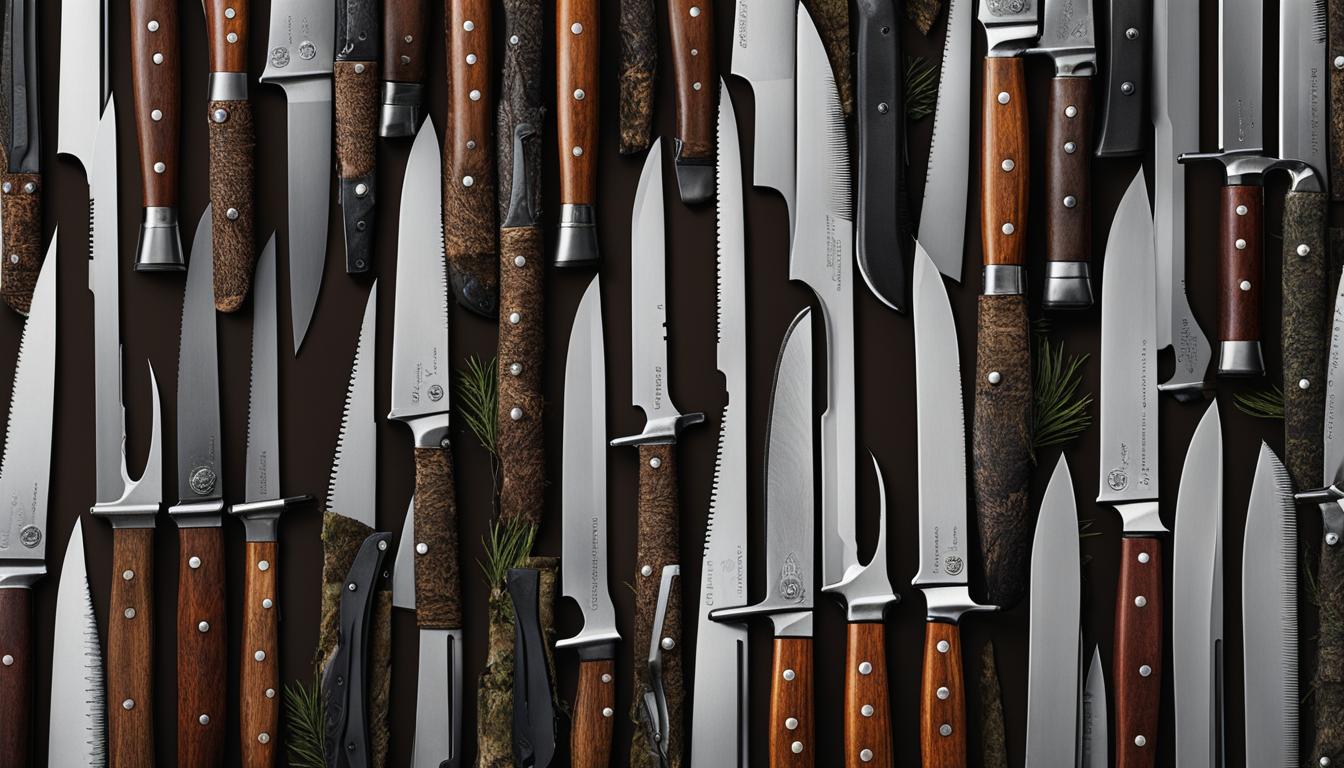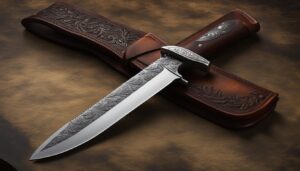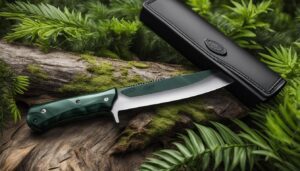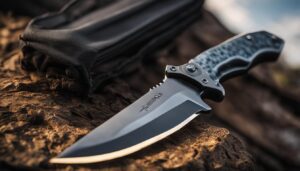When selecting a hunting knife, it’s important to consider the weight of the knife. Different types of knives have different weight preferences based on their intended use. Fixed-blade knives are popular for their strength and stability, making them a good choice for hunters and demanding outdoor tasks. Survival knives are versatile and durable, ideal for a variety of tasks. Folding or pocket knives offer portability and easy storage. EDC knives are lightweight and versatile tools for everyday use. Multi-tool knives combine a knife with other essential tools, making them perfect for outdoor enthusiasts. Fishing knives have a specialized design for cleaning and preparing fish. Consider your specific needs and preferences when choosing the ideal weight for your hunting knife.
Key Takeaways:
- Weight preferences in knives vary based on their intended use.
- Fixed-blade knives are known for their strength and stability.
- Survival knives are versatile and durable.
- Folding or pocket knives offer portability and easy storage.
- EDC knives are lightweight and versatile tools for everyday use.
Factors to Consider When Choosing a Hunting Knife
When it comes to selecting a hunting knife, there are several factors that should be taken into consideration. The choice of blade material and handle material are two essential aspects that can greatly impact the performance and durability of the knife. Here, we will explore these factors in greater detail.
Blade Material
The blade material of a hunting knife plays a crucial role in determining its overall performance. Different types of steel are commonly used for knife blades, each with its own advantages and characteristics. Stainless steel blades are known for their corrosion resistance and ease of maintenance. They are resistant to rust and staining, making them a popular choice among hunters. On the other hand, high-carbon steel blades offer superior strength, hardness, and edge retention. They are perfect for heavy-duty tasks and can withstand the rigors of outdoor use. It is important to consider the intended use of the knife and select a blade material that aligns with your specific needs.
Handle Material
The handle material of a hunting knife is equally important as it affects the comfort, grip, and durability of the knife. There are various options available for handle materials, including wood, bone, plastic, and synthetic materials. Wood handles offer a traditional and aesthetically pleasing look, but they require more maintenance and are susceptible to moisture and cracking. Bone handles provide a unique and natural appearance, but they may not be as durable as other materials. Plastic and synthetic materials, such as G-10 and Micarta, offer excellent strength, grip, and weather resistance. They are lightweight and require minimal maintenance. The choice of handle material should be based on personal preference, comfort, and the specific demands of your hunting activities.
By carefully considering the blade material and handle material, you can select a hunting knife that is tailored to your needs, preferences, and intended use. Remember to choose a knife that offers the right balance of performance, durability, and comfort to enhance your hunting experience.
Table: Blade and Handle Materials Comparison
| Blade Material | Advantages | Disadvantages |
|---|---|---|
| Stainless Steel | Corrosion resistance, easy maintenance | Less hardness, lower edge retention |
| High-carbon Steel | Superior strength, hardness, and edge retention | Can be prone to rust if not properly cared for |
| Handle Material | Advantages | Disadvantages |
|---|---|---|
| Wood | Traditional aesthetic, good grip | Require more maintenance, susceptible to moisture |
| Bone | Unique appearance, lightweight | Less durable, may crack under pressure |
| Plastic/Synthetic | Excellent strength, grip, and weather resistance | May lack the natural feel and aesthetics of other materials |
Maintenance and Care Tips for Your Hunting Knife
Proper maintenance and care are crucial for ensuring the longevity and optimal performance of your hunting knife. By following these essential tips, you can keep your knife in top condition and ready for any outdoor adventure.
1. Clean your knife after each use:
After every hunting trip or outdoor activity, it’s important to clean your knife to remove any dirt, debris, or moisture that may have accumulated. To clean the blade and handle, use warm water, mild soap, and a soft cloth or sponge. Avoid using harsh chemicals or abrasive materials that could damage the knife.
2. Dry your knife thoroughly:
Once you’ve cleaned your knife, make sure it is completely dry before storing it. Moisture can lead to rust and corrosion, compromising the blade’s integrity. Use a clean cloth to remove any excess water and allow the knife to air dry in a well-ventilated area.
3. Regularly sharpen the blade:
Keeping your knife sharp is essential for optimal cutting performance. Use a high-quality sharpening tool or sharpening stone to maintain a sharp edge. Follow the manufacturer’s instructions and take care not to over-sharpen the blade, as this can cause damage.
4. Lubricate moving parts:
If you have a folding knife, it’s important to lubricate the pivot area and locking mechanism to ensure smooth operation. Use a light oil or lubricant specifically designed for knives and apply a small amount to the moving parts. This will help prevent rust and ensure the knife is easy to open and close.
5. Store your knife properly:
When not in use, store your hunting knife in a dry, cool environment. Avoid storing it in a damp or humid area, as this can promote rust and corrosion. Consider using a knife sheath or storage case to protect the blade and prevent accidental cuts or damage.
By following these maintenance and care tips, you can extend the lifespan of your hunting knife and ensure it remains a reliable tool for all your outdoor adventures. Remember to always prioritize safety and handle your knife with caution.
| Maintenance Tips | Care Tips |
|---|---|
| Clean your knife after each use | Dry your knife thoroughly |
| Regularly sharpen the blade | Lubricate moving parts |
| Store your knife properly |
Following a regular maintenance routine will help keep your hunting knife in excellent condition, ensuring its reliability and performance when you need it most.
Additional Learning and Exploration in the World of Knives
Once you’ve chosen and become familiar with your hunting knife, there are several ways to further explore and develop your knowledge and skills. Whether you’re a beginner or an experienced hunter, engaging in knife skills workshops can provide valuable insights and practical training. These workshops offer hands-on learning opportunities that cover various topics such as knife safety, sharpening techniques, and advanced cutting methods. By attending these workshops, you can enhance your skills and become more knowledgeable about the proper use and maintenance of your hunting knife.
Another avenue to expand your expertise is by enrolling in outdoor survival courses. These courses not only teach you essential wilderness skills but also demonstrate how to effectively utilize your hunting knife in survival situations. From building shelters to preparing food, outdoor survival courses provide valuable insights on how to make the most of your hunting knife in challenging environments. These practical experiences can boost your confidence and equip you with the necessary skills to handle unexpected situations while out in the wilderness.
Being part of a knife community can also offer an excellent opportunity for learning and sharing knowledge. Joining online forums or social media groups dedicated to knives and outdoor enthusiasts allows you to connect with like-minded individuals. These communities provide a platform for discussing various knife-related topics, sharing experiences, and gaining valuable insights and advice. Engaging with the knife community can broaden your understanding of hunting knives, expose you to different perspectives, and foster a sense of camaraderie among fellow enthusiasts.
| Types of Knife Workshops | Duration | Location |
|---|---|---|
| Basic Knife Skills | 1 day | Local community centers |
| Advanced Cutting Techniques | 2 days | Dedicated knife skills facilities |
| Kitchen Knife Maintenance | 1 day | Specialty cooking schools |
“Joining knife skills workshops and outdoor survival courses can greatly enhance your understanding and proficiency with hunting knives. The opportunity to learn from experts and exchange knowledge with other enthusiasts is invaluable. Additionally, being part of a knife community allows you to connect with like-minded individuals and expand your network. Embrace these learning and exploration opportunities to take your hunting knife skills to the next level.”
Lastly, for those seeking a personalized touch, knife customization offers a unique way to make your hunting knife truly your own. Customization options range from engraved initials, unique blade finishes, to custom handle materials. Whether you prefer a sleek and minimalist design or a more ornate and eye-catching style, customization allows you to create a hunting knife that reflects your personality and tastes. Many skilled craftsmen and artisans specialize in knife customization, providing endless possibilities for creating a one-of-a-kind piece that is both functional and aesthetically pleasing.
Exploring these avenues of learning and customization can deepen your appreciation for hunting knives and equip you with the knowledge and skills to make the most of your chosen tool. Whether you are attending workshops, enrolling in survival courses, or connecting with the knife community, each experience contributes to your growth as a hunting enthusiast. Remember, the journey of learning and exploration is ongoing, and there is always something new to discover in the world of knives.
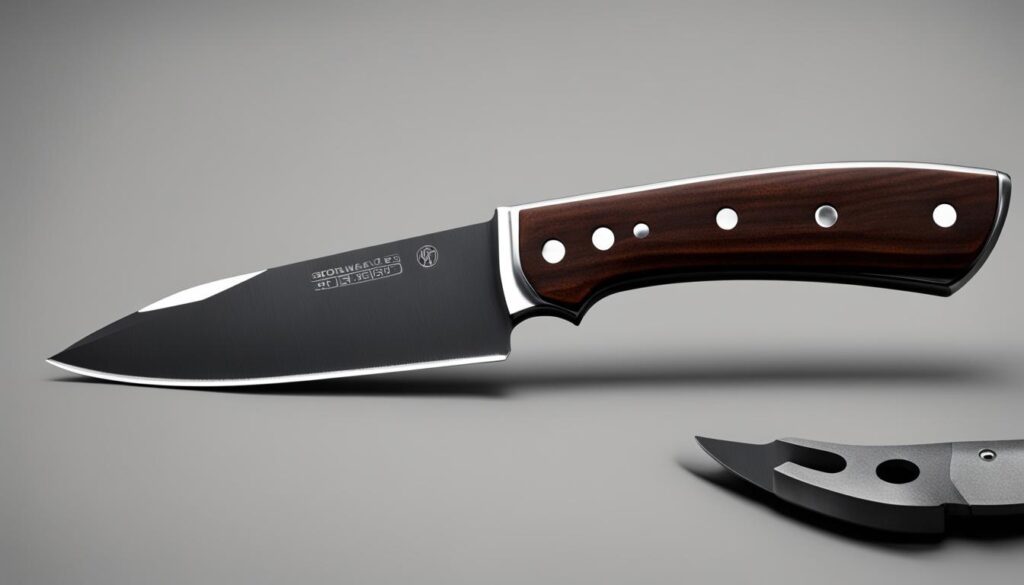
Understanding the History and Evolution of Knives
Knives have a rich and fascinating history that spans thousands of years. From their humble beginnings as stone tools to their modern-day designs, knives have evolved alongside human civilization, adapting to various needs and technological advancements. Exploring the history and evolution of knives allows us to appreciate the craftsmanship and ingenuity that goes into creating these essential tools.
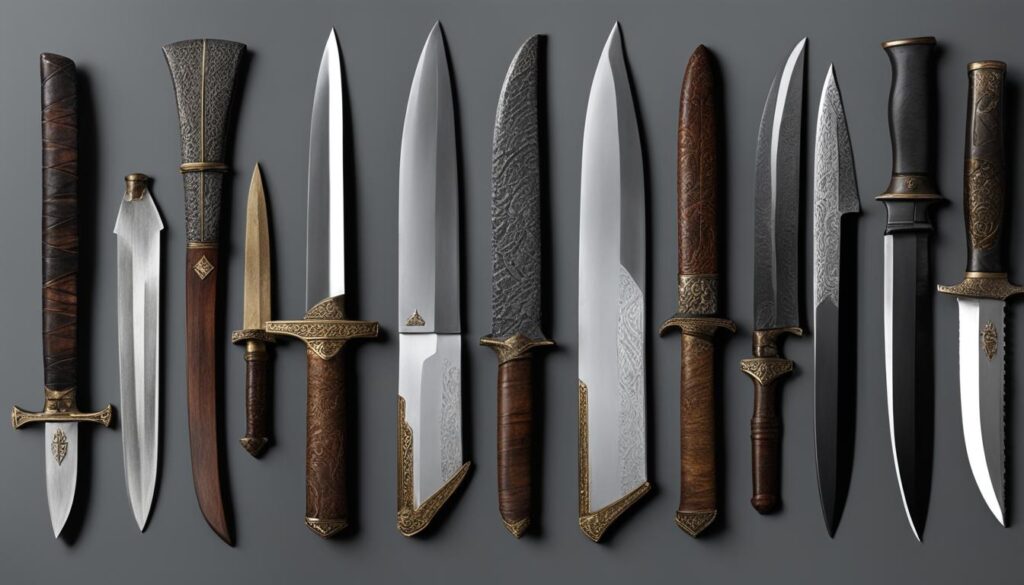

The Origins of Knives
The origins of knives can be traced back to prehistoric times when early humans created rudimentary blades from stone, bone, and other materials. These early knives served a vital role in hunting, cooking, and survival, representing one of the earliest tools ever used by humans. Over time, the development of metalworking techniques allowed for the creation of more refined and durable blades, paving the way for the evolution of knives.
Advancements in Design and Materials
As civilizations progressed, so did the design and materials used in knife production. Different cultures developed their own unique styles of knives, each with its specific purposes and aesthetic qualities. The introduction of iron and steel revolutionized knife production, providing blades with superior strength and sharpness. The craftsmanship of knives became more refined, with artisans honing their skills to create intricate designs and functional blades.
| Period | Notable Advancements |
|---|---|
| Ancient Times | Stone Tools |
| Medieval Period | Forging Techniques, Folding Blades |
| Industrial Revolution | Mass Production, Improved Blade Materials |
| Modern Era | Specialized Designs, High-Tech Materials |
The Significance of Knife Craftsmanship
Knife craftsmanship is a testament to the skill and dedication of the artisans who create these tools. From the meticulous shaping and grinding of the blade to the intricacies of handle construction, every aspect of knife making requires precision and expertise. Today, many knife makers continue to uphold traditional techniques, ensuring that the artistry and quality of craftsmanship are preserved for generations to come.
“The art of knife making is a blend of tradition and innovation, where technique meets creativity.” – Anonymous
Understanding the history and evolution of knives provides a deeper appreciation for these versatile tools. From their humble beginnings to the intricate designs of modern blades, knives have played a crucial role in human history. Whether you’re an adventurer, a chef, or a collector, recognizing the craftsmanship and legacy of knives can enhance your overall experience with these indispensable tools.
Top Hunting Knife Recommendations
When it comes to choosing the best hunting knife, there are many options available on the market. To help you make an informed decision, I have compiled a list of top hunting knife recommendations based on expert reviews and customer feedback. These knives have been praised for their quality, performance, and durability.
Recommended Hunting Knives
1. Spyderco Bill Moran Drop Point Hunting Knife:
- Blade Material: Stainless Steel
- Handle Material: Synthetic
- Features: Ergonomic design, excellent grip, and razor-sharp blade.
2. Buck Model 110 Hunter:
- Blade Material: High Carbon Steel
- Handle Material: Wood
- Features: Classic design, sturdy construction, and easy one-handed opening.
3. Fallkniven H1z:
- Blade Material: Laminated CoS Steel
- Handle Material: Thermorun
- Features: Full tang construction, excellent edge retention, and comfortable grip.
4. Gerber Gator Fixed Blade:
- Blade Material: High Carbon Stainless Steel
- Handle Material: Glass-Filled Nylon
- Features: Ergonomic handle, lightweight design, and corrosion-resistant blade.
5. Giant Mouse GMF2:
- Blade Material: Bohler M390 Stainless Steel
- Handle Material: Micarta
- Features: Handmade craftsmanship, premium materials, and exceptional cutting performance.
6. CRKT BIWA:
- Blade Material: 8Cr13MoV Stainless Steel
- Handle Material: G10
- Features: Compact size, lightweight, and versatile for backcountry hunts.
These top hunting knife picks offer a range of options to suit different preferences and budgets. Whether you’re looking for a reliable workhorse or a high-end custom knife, there is something for everyone. Consider the specific features and materials that matter most to you when making your decision. Remember, investing in a quality hunting knife is essential for a successful and enjoyable hunting experience.
| Knife | Blade Material | Handle Material | Features |
|---|---|---|---|
| Spyderco Bill Moran Drop Point Hunting Knife | Stainless Steel | Synthetic | Ergonomic design, excellent grip, and razor-sharp blade. |
| Buck Model 110 Hunter | High Carbon Steel | Wood | Classic design, sturdy construction, and easy one-handed opening. |
| Fallkniven H1z | Laminated CoS Steel | Thermorun | Full tang construction, excellent edge retention, and comfortable grip. |
| Gerber Gator Fixed Blade | High Carbon Stainless Steel | Glass-Filled Nylon | Ergonomic handle, lightweight design, and corrosion-resistant blade. |
| Giant Mouse GMF2 | Bohler M390 Stainless Steel | Micarta | Handmade craftsmanship, premium materials, and exceptional cutting performance. |
| CRKT BIWA | 8Cr13MoV Stainless Steel | G10 | Compact size, lightweight, and versatile for backcountry hunts. |
Note: Prices and availability are subject to change. Please check the manufacturer’s website or authorized dealers for the most up-to-date information.
“Investing in a quality hunting knife is essential for a successful and enjoyable hunting experience.”
Conclusion
In conclusion, choosing the ideal weight for hunting knives is a crucial consideration for hunting enthusiasts. Different types of knives have varying weight preferences based on their intended use. It’s important to think about factors such as purpose, size, weight, blade material, handle material, and budget when selecting a hunting knife.
Furthermore, proper maintenance and care are essential for the longevity and optimal performance of your hunting knife. Regular cleaning, sharpening, and lubricating will ensure that your knife stays in top condition. Storing the knife in a dry, cool environment will prevent rust and corrosion.
Exploring the world of knives through workshops, courses, and online communities can help expand your knowledge and skills. Additionally, considering the top hunting knife recommendations provided in this article can assist you in finding a knife that suits your needs and preferences.
Overall, prioritizing quality, functionality, and durability will lead you to make the best choice when selecting a hunting knife. With the right knife by your side, you can enhance your hunting experience and confidently embark on your outdoor adventures. Happy hunting!
FAQ
What should I consider when choosing the weight of a hunting knife?
When choosing the weight of a hunting knife, it’s important to consider the type of knife and its intended use. Different types of knives have different weight preferences based on their purpose. Fixed-blade knives are known for their strength and stability, making them a popular choice for hunters and demanding outdoor tasks. Survival knives are versatile and durable, suitable for various tasks. Folding or pocket knives offer portability and easy storage. EDC (Everyday Carry) knives are lightweight and versatile tools for everyday use. Multi-tool knives combine a knife with other essential tools, making them perfect for outdoor enthusiasts. Fishing knives have a specialized design for cleaning and preparing fish. Consider your specific needs and preferences when choosing the ideal weight for your hunting knife.
What factors should I consider when choosing a hunting knife?
When selecting a hunting knife, there are several factors to consider. First, think about the primary tasks you’ll be using the knife for, such as skinning, field dressing, or general outdoor tasks. This will help determine the ideal blade length and type of knife. Size and weight are also important considerations, as smaller, lighter knives may be more convenient for everyday use or long hikes, while larger, heavier knives offer more strength and stability. Blade material is significant for performance, sharpness, and durability, with options like stainless steel and high-carbon steel. The handle material affects comfort, grip, and durability, with choices like wood, bone, plastic, and synthetic materials. Finally, set a budget and choose a knife within your price range.
How do I properly maintain and care for my hunting knife?
Proper maintenance and care are essential for the longevity and optimal performance of your hunting knife. After each use, clean your knife thoroughly to remove dirt, debris, and moisture. Use warm water, mild soap, and a soft cloth or sponge to clean the blade and handle, and ensure the knife is completely dry to prevent rust and corrosion. Regularly sharpen your knife to maintain its edge and cutting performance. Lubricate the pivot area and locking mechanism of folding knives for smooth operation. Store your knife in a dry, cool environment to prevent rust and corrosion. Routine inspection will help identify any wear, damage, or rust that needs to be addressed promptly.
How can I further explore and develop my knowledge and skills with hunting knives?
Once you’ve chosen and become familiar with your hunting knife, there are several ways to further explore and develop your knowledge and skills. Consider attending knife skills workshops or classes to learn about knife safety, sharpening techniques, and advanced cutting methods. Enroll in outdoor survival courses to learn essential wilderness skills and how to use your knife in survival situations. Join online forums or social media groups dedicated to knives and outdoor enthusiasts to connect with like-minded individuals and gain valuable insights and advice. Explore customization options for your knife, such as personalized engravings or custom handle materials. Finally, expand your collection of knives to have options for different purposes and blade types.
What can I learn by understanding the history and evolution of knives?
To gain a deeper appreciation for knives and their craftsmanship, it’s worthwhile to learn about their history and evolution. Knives have been used for thousands of years, with early examples dating back to prehistoric times. Throughout history, knives have evolved in design, materials, and usage, reflecting the needs and advancements of different civilizations. Learning about the origins and development of knives can provide a deeper respect for the skills and innovation that go into creating these versatile tools. By examining the history of knives, you can gain a better understanding of the craftsmanship and quality that goes into the production of modern hunting knives.
What are some top hunting knife recommendations?
Here are some top hunting knife recommendations based on expert reviews and customer feedback. The Spyderco Bill Moran Drop Point Hunting Knife is highly regarded for its quality and performance. The Buck Model 110 Hunter is an iconic knife known for its durability and versatility. The Fallkniven H1z offers a perfect balance of design and functionality. The Gerber Gator Fixed Blade is a budget-friendly option that doesn’t compromise on quality. The Giant Mouse GMF2 is a handmade knife with excellent build quality and performance. The CRKT BIWA is a compact and lightweight option ideal for backcountry hunts. Consider these recommendations when choosing a hunting knife that suits your needs and preferences.
